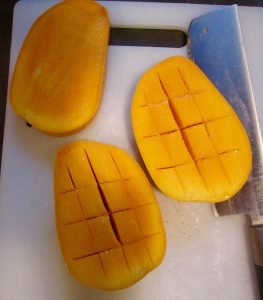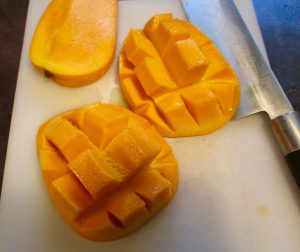Every morning I carefully, thoughtfully, cut up a fragrant, ripe, plump mango and add its meat to my healthy, tropical-fruit, breakfast smoothie. Mangoes, considered the king of fruits, are, hands down, my favorite fruit — way beyond the sweet, summer-fresh Jersey peaches I grew up on. Mangoes, in fact, are one of the many reasons I prefer to live in the tropics — where mangoes grow in profusion.
Mexico is one of the five top mango producers in the world, after India, China, Thailand, and Indonesia. Portuguese explorers in the 16th century are credited with introducing mangoes to Brazil and Africa, after they’d “discovered” the fruit in India. It has since become one of the most widely cultivated fruits in the tropics, with over five hundred varieties known worldwide.
I’ll never forget the first time I discovered mangoes, about a half century ago, when I was in my mid-twenties, living in southern Africa. Walking home from work one day, I noticed what looked to me like the carcass of a huge, fuzzy insect on the sidewalk.
“What’s THAT?!” I asked my co-worker Bev Owen, who was walking beside me.
“That’s just a mango pit, silly,” she said. “Haven’t you ever eaten a mango? They’re lovely! And soooooo juicy! When my sisters and I were little, my mom would put us in the tub, naked, after dinner, give us each a peeled mango, and let us have fun getting totally covered in sweet, sticky mango juice as we ate the luscious fruit as our dessert. Then she’d rinse us off, soap us up, and give us our warm baths before bed.”
I soon made up for my late-in-life introduction to mangoes by eating them at every opportunity.
Back in the States, where mangoes have to travel far from their tropical homelands, I found that this fruit can be pricey. But, I rationalized, using my Mom’s favorite maxim, “It’s better to pay the grocer than the doctor,” mangoes are cheaper than medicine. They’re filled with goodness – high in Vitamins C and A, low in calories, with zero fat – and packed with added benefits, such as helping to facilitate healthy digestion, boost immunity, lower cholesterol, promote eye health, and aid in weight loss.
Years later, when I returned to Africa to live and work, mangoes, which are plentiful and affordable there, always featured prominently in my diet. In the Peace Corps in Gabon, I edited a cookbook for volunteers’ benefit called The Gabon Gourmet (3rd edition, 1997) and included in it as many mango recipes as I could, such as this über-easy one for Mango Frozen Yogurt: Combine 1-1/2 cups freshly pureed mango pulp, 1-1/2 cups plain yogurt, ½ cup sugar, and freshly squeezed lemon juice to taste; blend well, chill, then freeze.
Another mango memory that returns to me when I cut up my mangoes in the mornings here in San Miguel de Allende, Mexico, is this one, from Mali, West Africa, after my Peace Corps service:
One Friday in mid-May, 1999, I held a cooking lesson at my home in Ségou for some of the members of a women’s center where I volunteered. (This was before I began teaching them, at their request, patchwork quilting, an experience I wrote all about in my memoir, How to Make an African Quilt.) The lesson that day in May was on “Confiture de Mangue” (mango jam), which the women told me they’d never tasted, despite the fact that mango trees grow everywhere in Mali, and mangoes are abundant.
I’d asked the core group of five teachers at the center to arrive at 4 o’clock and each bring a clean, empty jar and a small bag of mangoes. I agreed to supply the rest: lemons, sugar, photocopies of the recipe, labels for the jars, kitchen equipment, and gas stove.
To my surprise, about a dozen Malian women, all beautifully dressed in flowing boubous and matching turbans, pulled up to my house at four-ish on their motorbikes, carrying enormous bowls and buckets filled with fat, perfectly ripe mangoes.
With an overabundance of fruit and more eager students than I’d bargained for — yet only two stovetop burners and two decent-size pots in my small kitchen — we had to make do.
I gave the women a basic lesson. Then, with a view to their one day making and selling this jam in their gift shop, I showed them how to label and decorate filled jars with a round of colorful African fabric and a bowtie of colored yarn.
When our mango jam had finished cooking, the women filled their freshly sterilized jars so that each of them had a jar of jam to take back to her family. There was no need to label and decorate the jars, the women told me, because their large families would eat all of it, slathered on bread, just as soon as they reached home.
~ ~ ~
How to Tackle a Mango
If you’re unsure how to choose or cut up a mango, here’s my approach: Buy firm-ish, unbruised, slightly under-ripe (a tad green) mangoes and allow them to ripen at room temperature in a fruit bowl in your kitchen for a couple of days, depending on their under-ripeness when bought.
When they’re no longer green and they have a slight “give” when gently pressed, they’re ready to cut open. Carefully slice off both sides, following the contours of the pit:
Then cut crosshatch patterns into the flesh, being sure not to cut through to the leathery skin:
Invert the crosshatched sections and cut off chunks of the sweet fruit to eat:
Tropical-Fruit Smoothie
You can find the recipe for my healthy breakfast smoothie by going to www.blog.bonnieleeblack.com/blender-memories/ . I now add plain yogurt to this recipe, for added calcium and protein.




